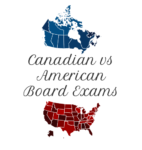A Breakdown of Canadian vs. American Optometry Board Exams

Disclaimer: This information was last updated Jan 25, 2019. For the most updated information and current test administration dates, please consult the OEBC for Canadian boards or the NBEO for American boards.
If you’re a Canadian wanting to practice or do a residency in the States, a Canadian at an American optometry school or an American with ties to the True North – chances are, you’re thinking about taking both board exams.
The Canadian board exam consist of two parts, and is administered by the Optometry Examining Board of Canada (OEBC). The American board exam consist of three parts, and is administered by the National Board of Examiners in Optometry (NBEO). It is important to keep in mind that the NBEO American exam has to be successfully completed if you are a Canadian planning to do a residency in the United States.
Recently, the College of Optometrists of Ontario (COO) announced that they will be accepting the NBEO exam to practice in the province of Ontario if each part of the exam was successfully challenged after January 18, 2019. Currently, the province of British Columbia also accepts the NBEO, but the OEBC (Canadian) exam is required to practice in all other provinces and territories in Canada.
The OEBC (Canadian) exam consist of two parts, Part I – Written Exam and Part II – Objective Structured Clinical Examination (OSCE). The cost to take this exam is $2,000 CAD for Part I and $3,900 CAD for Part II. The total cost is $5,900 CAD, or approximately $4,417 USD.
Part I of the OEBC exam consists of 62 comprehensive cases, each with 4 multiple choice questions. It is a comprehensive exam of case management and includes topics such as ocular disease, contact lenses, refraction, binocular vision, and the like. It is conducted in a testing center in Hamilton, Ontario, Canada (for English) and Montreal, Quebec, Canada (for French). Part 2 of the OEBC exam is a practical skills exam, and is also conducted in Hamilton.
The NBEO (American) exam consists of three parts – Part I – Applied Basic Science, Part II – Patient Assessment and Management and Part III – Clinical Skills. The cost to write this exam is $725 USD per part, or $2, 175 USD total, which is approximately $2, 883 CAD. Part I and II can be written in testing centers across Canada and the United States, however, Part III must be taken in Charlotte, North Carolina.
Part I of the NBEO exam consists of 350 scored and 20 non-scored items, divided into 185 items per session. There are 2 sessions in which you are given 4 hours each, for a total of 8 hours to complete the exam. The topics tested include anatomy, biochemistry, physiology, immunology, microbiology, pathology, optics and pharmacology, with an emphasis on the oculo-visual system. Part II of the NBEO exam consists of 45-55 full cases, 15-20 solo items, and 15-25 minicases. Topics covered include ocular disease, contact lenses, refraction, binocular vision and the like. It is a comprehensive case management exam of everything you learned in optometry school. Part III of the NBEO exam is a test of practical skills and consists of the clinical skills and injection skills exam. This exam is offered only in Charlotte, North Carolina.
As you can see, Part I OEBC and Part II NBEO are quite similar, so you may consider studying for and writing these exams within the same timeframe. Additionally, Part II OEBC and Part III NBEO are similar practical skill examinations, however the administration and the skills tested can vary and require targeted preparation. Part II OEBC (the OSCE) focuses more on counselling scenarios, and any clinical techniques are done on models to provide a consistent objective evaluation, while Part III NBEO requires performing techniques on live patients.
For students choosing to write both board exams, the process can be extensive and requires planned preparation. Part I OEBC is offered in French and English in November of the students’ final year, and Part II OEBC is offered in the following May. However, Part I may also be written several days prior to Part II.
These exams have to be taken in Hamilton. Part I NBEO is offered in March of third year and the following August, but most students not studying in the US choose to take it in August during their fourth year. Part II NBEO is offered in December of the fourth year or the following April, but most students in both the US and Canadian schools choose to take it in December of their final year. Part III NBEO can be scheduled at any time starting August of fourth year in Charlotte.
Many Canadian students choose to take both board exams to do a residency, keep the borders fluid, or challenge themselves in their clinical knowledge. Most of the preparation materials are equivalent, and the content is similar between the two board exams. No matter why you take both, there is no doubt that you will be a more knowledgeable clinician in the process. Best of luck on your board exams!
Anyone with questions about how I tackled studying for boards is welcome to contact me personally.
Feel free to DM @drserenehappy on Instagram or email me at sherenevazhappilly@gmail.com.

